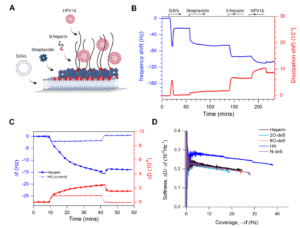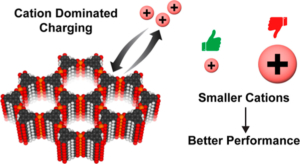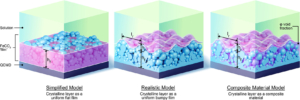Site-specific sulfations regulate the physicochemical properties of papillomavirus–heparan sulfate interactions for entry
Authors: Fouzia Bano, Laura Soria-Martinez, Dominik van Bodegraven, Konrad Throsteinsson, Anna M. Brown, Ines Fels, Nicole L. Snyder, Marta Bally, Mario Schelhaas
Journal: Science Advances
 Abstract: Certain human papillomaviruses (HPVs) are etiological agents for several anogenital and oropharyngeal cancers. During initial infection, HPV16, the most prevalent cancer-causing type, specifically interacts with heparan sulfates (HSs), not only enabling initial cell attachment but also triggering a crucial conformational change in viral capsids termed structural activation. It is unknown, whether these HPV16-HS interactions depend on HS sulfation patterns. Thus, we probed potential roles of HS sulfations using cell-based functional and physicochemical assays, including single-molecule force spectroscopy. Our results demonstrate that N-sulfation of HS is crucial for virus binding and structural activation by providing high-affinity sites, and that additional 6O-sulfation is required to mechanically stabilize the interaction, whereas 2O-sulfation and 3O-sulfation are mostly dispensable. Together, our findings identify the contribution of HS sulfation patterns to HPV16 binding and structural activation and reveal how distinct sulfation groups of HS synergize to facilitate HPV16 entry, which, in turn, likely influences the tropism of HPVs.
Abstract: Certain human papillomaviruses (HPVs) are etiological agents for several anogenital and oropharyngeal cancers. During initial infection, HPV16, the most prevalent cancer-causing type, specifically interacts with heparan sulfates (HSs), not only enabling initial cell attachment but also triggering a crucial conformational change in viral capsids termed structural activation. It is unknown, whether these HPV16-HS interactions depend on HS sulfation patterns. Thus, we probed potential roles of HS sulfations using cell-based functional and physicochemical assays, including single-molecule force spectroscopy. Our results demonstrate that N-sulfation of HS is crucial for virus binding and structural activation by providing high-affinity sites, and that additional 6O-sulfation is required to mechanically stabilize the interaction, whereas 2O-sulfation and 3O-sulfation are mostly dispensable. Together, our findings identify the contribution of HS sulfation patterns to HPV16 binding and structural activation and reveal how distinct sulfation groups of HS synergize to facilitate HPV16 entry, which, in turn, likely influences the tropism of HPVs.


 Abstract:
Abstract: 

 This paper reports the real time monitoring of siderite deposition, on both Au- and Fe-coated surfaces, using the changes in frequency and dissipation of quartz crystal microbalance with dissipation (QCMD). In an iron chloride solution saturated with carbon dioxide, buffered with sodium bicarbonate to pH 6.8, roughly spherical particles of siderite formed within 15 min, which subsequently deposited on the QCMD crystal surface. Imaging of the surface showed a layer formed from particles ca. < 0.5 μm in diameter. Larger particles are clearly deposited on top of the lower layer; these larger particles are >1 μm in diameter. Monitoring of the frequency clearly differentiates the formation of the lower layer from the larger crystals deposited on top at later times. The elastic moduli calculated from QCMD data showed a progressive dissipation increase; the modeling of the solid–liquid interface using a flat approximation resulted in a poor estimation of elastic and storage moduli. Rather, the impedance modeled as a viscoelastic layer in contact with a semi-infinite liquid, where a random bumpy surface with a Gaussian correlator is used, is much more accurate in determining the elastic and storage moduli as losses from the uneven interface are considered. A further step considers that the film is in fact a composite consisting of hard spherical particles of siderite with water in the vacant spaces. This is treated by considering the individual contributions of the phases to the losses measured, thereby further improving the accuracy of the description of the film and the QCMD data. Collectively, this work presents a new framework for the use of QCMD, paired with traditional approaches, to enhance the understanding of crystal deposition and film formation as well as quantify the often evolving mechanical properties.
This paper reports the real time monitoring of siderite deposition, on both Au- and Fe-coated surfaces, using the changes in frequency and dissipation of quartz crystal microbalance with dissipation (QCMD). In an iron chloride solution saturated with carbon dioxide, buffered with sodium bicarbonate to pH 6.8, roughly spherical particles of siderite formed within 15 min, which subsequently deposited on the QCMD crystal surface. Imaging of the surface showed a layer formed from particles ca. < 0.5 μm in diameter. Larger particles are clearly deposited on top of the lower layer; these larger particles are >1 μm in diameter. Monitoring of the frequency clearly differentiates the formation of the lower layer from the larger crystals deposited on top at later times. The elastic moduli calculated from QCMD data showed a progressive dissipation increase; the modeling of the solid–liquid interface using a flat approximation resulted in a poor estimation of elastic and storage moduli. Rather, the impedance modeled as a viscoelastic layer in contact with a semi-infinite liquid, where a random bumpy surface with a Gaussian correlator is used, is much more accurate in determining the elastic and storage moduli as losses from the uneven interface are considered. A further step considers that the film is in fact a composite consisting of hard spherical particles of siderite with water in the vacant spaces. This is treated by considering the individual contributions of the phases to the losses measured, thereby further improving the accuracy of the description of the film and the QCMD data. Collectively, this work presents a new framework for the use of QCMD, paired with traditional approaches, to enhance the understanding of crystal deposition and film formation as well as quantify the often evolving mechanical properties. Drying oils such as linseed oil form a polymer network through a complex free-radical polymerization process. We have studied polymerization in this challenging class of polymers using a quartz crystal microbalance (QCM). The QCM is able to measure the evolution of polymer mass and mechanical properties as the oil transitions from a liquid-like to a solid-like state. Measurements using bulk materials and thin films provide information about the initial polymerization phase as well as the evolution of the mass and mechanical properties over the first two years of cure. The temperature-dependent response of the cured linseed oil films was also measured. These results were combined with previously published results obtained from traditional dynamic mechanical analysis to give a unified picture of the properties of these materials across a very broad temperature range.
Drying oils such as linseed oil form a polymer network through a complex free-radical polymerization process. We have studied polymerization in this challenging class of polymers using a quartz crystal microbalance (QCM). The QCM is able to measure the evolution of polymer mass and mechanical properties as the oil transitions from a liquid-like to a solid-like state. Measurements using bulk materials and thin films provide information about the initial polymerization phase as well as the evolution of the mass and mechanical properties over the first two years of cure. The temperature-dependent response of the cured linseed oil films was also measured. These results were combined with previously published results obtained from traditional dynamic mechanical analysis to give a unified picture of the properties of these materials across a very broad temperature range.
